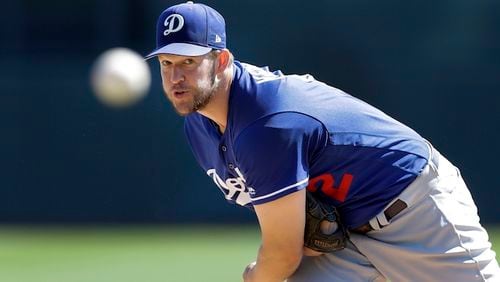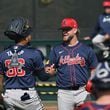It's been all sunshine, rainbows and lollipops in Los Angeles Dodgers camp.
There's a presumption of success here and it's justified. The Dodgers reached the World Series last year and played in the National League Championship Series the year before that. Most of the key players are back. So is the manager. The once-skeptical fan base is now convinced the front office knows what it's doing.
The widespread assumption is the Dodgers will cruise to a sixth consecutive National League West championship, and that very well could be the case.
So now is probably the right time for a quick reality check.
The machine could unravel this season.
It's not worth wagering a mortgage payment on that possibility, but the chance of a disaster is nonetheless very real and very present.
Based on the team's recent track record, the culprit would be the unlikeliest of suspects: the starting rotation.
The group will continue to be headlined by the best pitcher in baseball in Clayton Kershaw, but the depth that made it the top collective unit in the sport has been eroded by financial considerations.
"That's fair," manager Dave Roberts said. "We don't have the starting pitching depth that we've had in past years."
Moving under the luxury-tax threshold and adhering to Major League Baseball's debt service rule prevented the Dodgers from making a serious effort to re-sign Yu Darvish. They also traded Brandon McCarthy and Scott Kazmir to the Atlanta Braves.
Darvish, who was acquired at the July 31 non-waiver trade deadline, posted a 3.44 ERA in nine starts over the last two months of the regular season. McCarthy started 16 games for the Dodgers last season and posted a 3.98 ERA. Kazmir won 10 games for the Dodgers in 2016.
The Dodgers bolstered their lineup in the trade by acquiring Matt Kemp, but are now at the mercy of the health of the five pitchers in their rotation: Kershaw, Rich Hill, Alex Wood, Kenta Maeda and Hyun-Jin Ryu.
All five pitchers were on the disabled list last season and have disconcerting medical histories.
"Look, I think you're right," general manager Farhan Zaidi said. "You can't view it as a five-man rotation. It's got to be a 162-game rotation and where do those 162 starts come from?"
But Zaidi remains optimistic.
The group was relatively durable last season, with Ryu making 24 starts; Hill, Wood and Maeda 25 each; and Kershaw 27.
"We try to manage these guys individually to allow for them to get through a major league season," Roberts said.
The strategy included giving Maeda and Ryu extra days between starts by placing them on the disabled list with — how do we say this? — very suspicious-looking injuries.
Only now, providing Maeda and Ryu with a breather wouldn't be someone of McCarthy's credentials, but instead a less experienced option.
If a starter has to be placed on the disabled list in the first month of the season, the Dodgers probably will call on Ross Stripling or Brock Stewart.
Rookie fireballer Walker Buehler will be an option, but not until later in the season. The Dodgers are planning to do with him what they did with Julio Urias last season, preserving his arm by limiting his early-season workload. Of course, Urias sustained a major shoulder injury and won't be available until some time in the second half of this season.
The team could lose a starter and still survive. But what if two or three of them go down? If the Dodgers misjudged the ability of their young pitchers, they could be in serious trouble.
Zaidi said the organization wanted to provide opportunities to its pitching prospects. "With the younger guys, we want them to feel like they have a chance to impact this team, not just be guys seven through 10 on the starting pitching depth chart," he said.
But how much of that was forced on the Dodgers by their financial objectives?
"I think it was a little bit of both," he said.
The situation could be compounded by uncertainty in the bullpen, where the Dodgers are uncertain of what they have outside of All-Star closer Kenley Jansen. Standout setup man Brandon Morrow signed with the Chicago Cubs. Morrow's designated replacement, Tom Koehler, is sidelined indefinitely with a shoulder injury.
"Like with every team, I think we view our roster and the pitching staff as something that's going to evolve over the course of the season," Zaidi said. "Guys are going to emerge and if needs arise, we have the resources and farm system to address them."
In other words, they could do something similar to what they did last season when they sent a package of prospects to the Texas Rangers for Darvish, who became the team's No. 2 pitcher behind Kershaw and a part of the team's postseason rotation.
The Dodgers were already postseason bound when they acquired Darvish. The trade was a viewed as a luxury, the kind of move that could potentially transform a playoff team into a World Series champion.
If the worst-case scenario unfolds, they could have to make a trade like that just to contend.
About the Author






